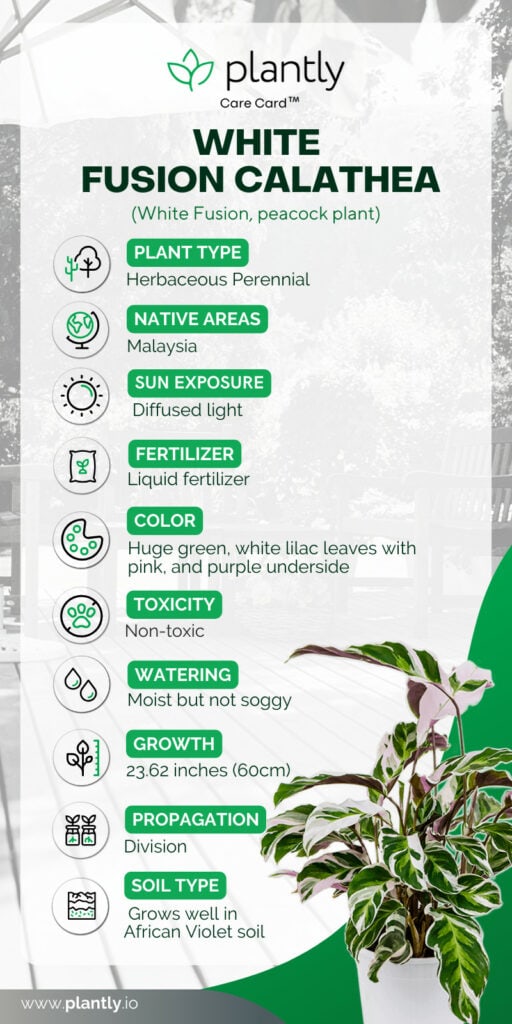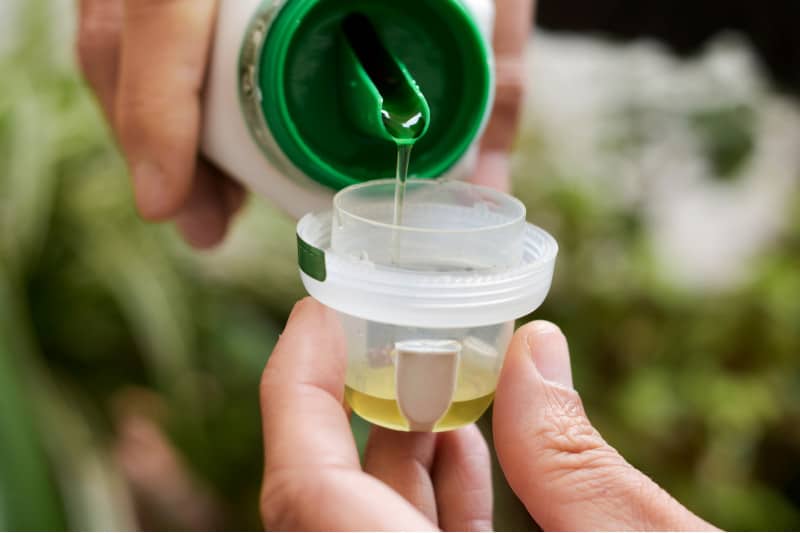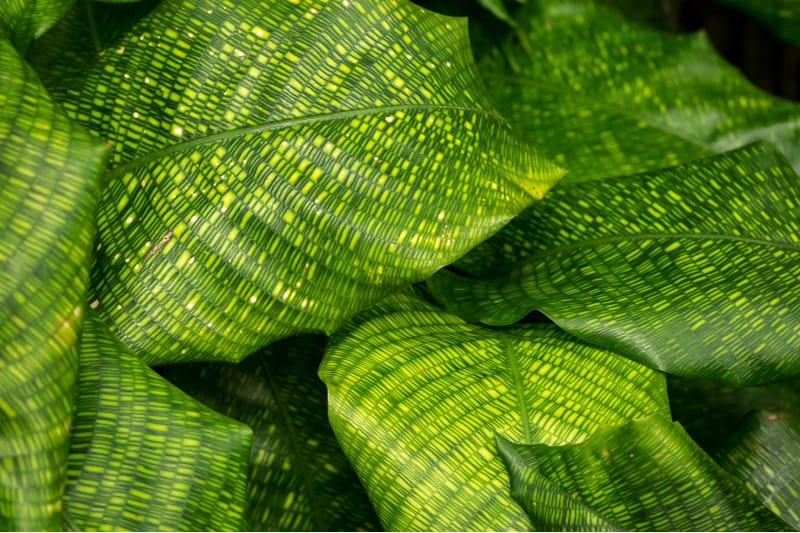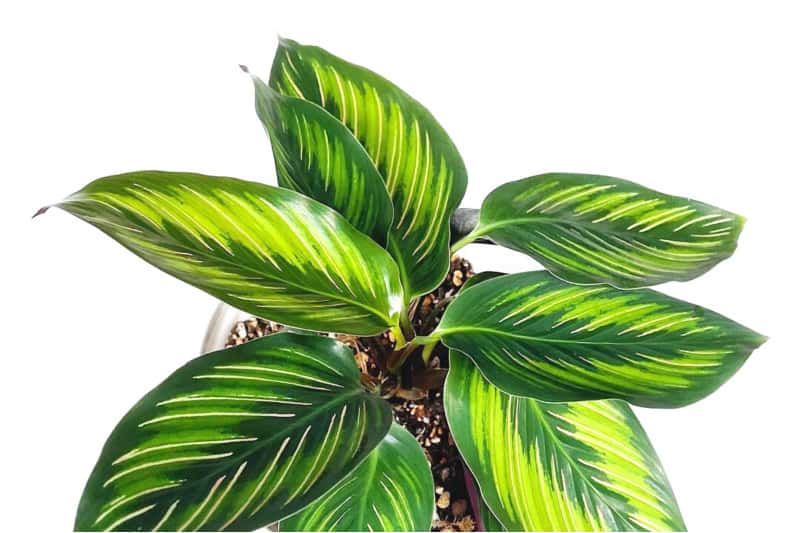No products in the cart.
Table of Contents
Another valued house plant is the Calathea White Fusion primarily because of its stunning color. One thing standing out is the enormous glossy white striped leaves with a purple underside. Gardeners refer to it as the peacock, rattlesnake, or zebra.
Yet, its botanical name is the Calathea lietzei. Today we are going to dig deeper into taking care of this fusion white plant.
What is the White Fusion Calathea
The Calathea white fusion is the queen of the prayer-plants in the Marantaceae family. The reason is that it closes up it leaves at night, making for an exciting display. The ornamental plant has variegated shades of green, white, and lilac.
On the leaf underside, it is light purple pinkish and along the stems. As mentioned, many people refer to it as the peacock plant. But it would help if you did not confuse it with the Calathea makoyana. Further, it is a new cultivar discovered by Taiyan Yam in 2007 at a nursery in Malaysia.
So for a short introduction to the White Fusion Calathea, look at the information that follows here.

Calathea White Fusion Care
White fusion Calathea is very specific when it comes to care and maintenance. Yet, once you know the basics and with a little extra effort, it’s going to be worthwhile.
Recommended Potting Soil
Rich, moist soil is key for calathea plants. So having suitable draining soil is crucial. For example, you can use African Violets soil that is peaty enough to hold moisture and allow good drainage. Or you can make potting soil by mixing the materials below:
- Six portions of Orchid bark or clay pebbles
- Four portions coco coir
- Four portions perlite
- Two-part pumice
- A small amount of sphagnum moss
Water Condition
Your Fusion White loves moist but not soggy soil. If it is too wet, it can lead to root rot. Not sure how to check if your plant needs water? No problem, all you do is stick your finger in the soil. If the ground is dry the first couple of inches, then you can water your houseplant.
Allow any excess water to drain at the bottom to keep your Calathea happy. Now, your plant is also sensitive to fluoride that may be present in tap water. It’s best to provide it with bottled or filtered water.
Or you can fill a buck of rainwater and store it for future use.
FYI:
Calathea plants prefer rainwater or distilled water. Tap water makes their leaves turn brown due to the chlorine present in them.
The Best Lighting Conditions
The Calathea White Fusion comes from warm climates and grows in diffused light under tree canopies. So it helps to mimic the same habitat for your plant to be happy. You can place them in filtered bright light but not under direct sunlight.
Doing this provides them with the right amount of sun to prevent those beautiful markings from fading. Too much sun will cause the leaves to curl. So you can place them at the window using a sheer curtain to keep the foliage protected in bright sunlight.
This is ideal if you want to treat your calathea as an indoor plant.
Temperature Necessity

You will notice your Calathea white loves a warm room temperature. So if you can keep the temperature between 60° to 80° F (15 – 27°C), your plant will thrive. Also, do not place your houseplant near an air conditioner, draft, or heating source.
Doing this can lead the plant to dry out easily and even suffer from physical damage.
Recommended Humidity Levels
Your White Fusion Calathea needs a high humidity level of 85%. This condition is desirable for the plant’s growth. To achieve this, it helps to invest in a humidifier as your plant will fall in love with it. Or you can place it in the bathroom when showering.
You can also place your plant on a pebble tray with water but only filled up to the pebbles. The best part is if you have more than one Calathea, you can group them with other house plants.
Fertilizer Needs

The good news is your Calathea white loves feeding in the growing season from spring to autumn. We recommend using a balanced 10:10:10 liquid fertilizer diluted with water. If you prefer organic feeding, you can find some commercial ones available.
Or you can fill a bucket to the halfway mark with rich compost and water. Leave your compost tea to stand for a couple of days and strain. Now dilute it further in half with water.
You can use this fertilizer on all your houseplants. When winter arrives, you can stop feeding your plant. An important note is to never fertilize the Calathea plant after repotting.
Calathea White Propagation
Once it grows big, you can start propagating Calathea White Fusion. To do this, you can use the large clumps on the sides. You can separate these clumps to grow new plants. We recommend doing this in spring and summer.
- Water your plant well a few days before the time.
- You can start by removing the old soil and dividing the plant using the natural separation of the roots. Yet, those roots are fragile, so be gentle.
- Take new pots and add the proper mix of soil used before and plant them in them.
- Please place them in a moist yet warm place with reduced light for a couple of weeks.
- When you notice new growth, you can place your plants back in their original spot.
The only problem with using this method is that your Calathea white loses that lush look. Yet, with some tender loving care, it will grow back to itself again.
Calathea White Fusion Growth Zone
To grow Calathea as an outdoor plant, it’s best to live in the USDA hardiness zones 11 to 12.
Potting and Pruning the Calathea White
Your Calathea is a slow grower and needs repotting once a year at the most. After that, you can provide your plant with size bigger pot. If you do not want your houseplant to grow too big, you can use the same container.
But before you place it back in that pot, clean it well and freshen up the soil. The best time to do this is in spring. Then, you only need to prune the Calathea when you notice damaged, browned, or curled leaves. Do this by cutting the ailing leaf at the stem.
Calathea Varieties
If you love the Calathea White Fusion, then you may also love to have the following varieties in your home:
Calathea musaica

The plant has a mosaic pattern on the leaves and is a rare plant if you have one. The intricate network of yellow-green lines looks spectacular when light shines through the leaves.
Calathea orbifolia

Calathea orbifolia has vast leaves striped with silver bands, making it beautiful to have in the home. Unfortunately, it is also one of the giant Calathea plants you can find. Another quality of the plant is that it has an air-purifying nature.
Calathea Beauty Star

Calathea beauty star has narrow dark green leaves with stripes of silver, white, and pale green. The underside of the leaf is purple. The Calathea White Fusion also closes its leaves at night and raises them in the morning.
Calathea White Fusion Diseases & Pests
Your Calathea White Fusion has one big problem, and that is overwatering, leading to root rot. So planting your houseplant in well-draining soil is crucial. If you have your plant in a cachepot, it helps to remove it from the vessel when watering to drain the water.
Suppose you notice the problem with the roots. We recommend removing them from the old soil. You can cut the damaged roots, stems, and leaves to replant them in a fresh potting mix. If the leaves are crisp and curling, it needs more watering, or the humidity is not high enough.
Curling leaves can result from too much bright light, while crisping leaves can be from tap water. The only way to correct this is to move your plant into indirect light and provide it with water.
Frequently Asked Questions
When the Calathea White Fusion gets too dry, the leaves turn brown and become crispy. The opposite happens when you overwater it as the leaves turn yellow-brown. The important thing is to keep checking the soil. Use the finger method to feel if the soil is still moist or dry to touch.
When the leaves curl and become crisp, they can be from too much direct sunlight. Or the chemicals in the tap water make it brittle. It can also be that it is underwater or the humidity levels need adjusting
As with any houseplant, chlorophyll is essential for photosynthesis. Especially in variegated plants. If your plant does not get enough of it, the variegation returns to green. So placing it in moderate to bright indirect light helps.
Finding the Calathea White Fusion is not too hard searching online. Of course, you can also visit your local nursery. But there is no need to do that as Plantly has this gorgeous plant available. Even better, you receive it delivered to your door.
Whether you want to buy, sell or simply reach out to other plant enthusiasts, Plantly is the right place to be!


